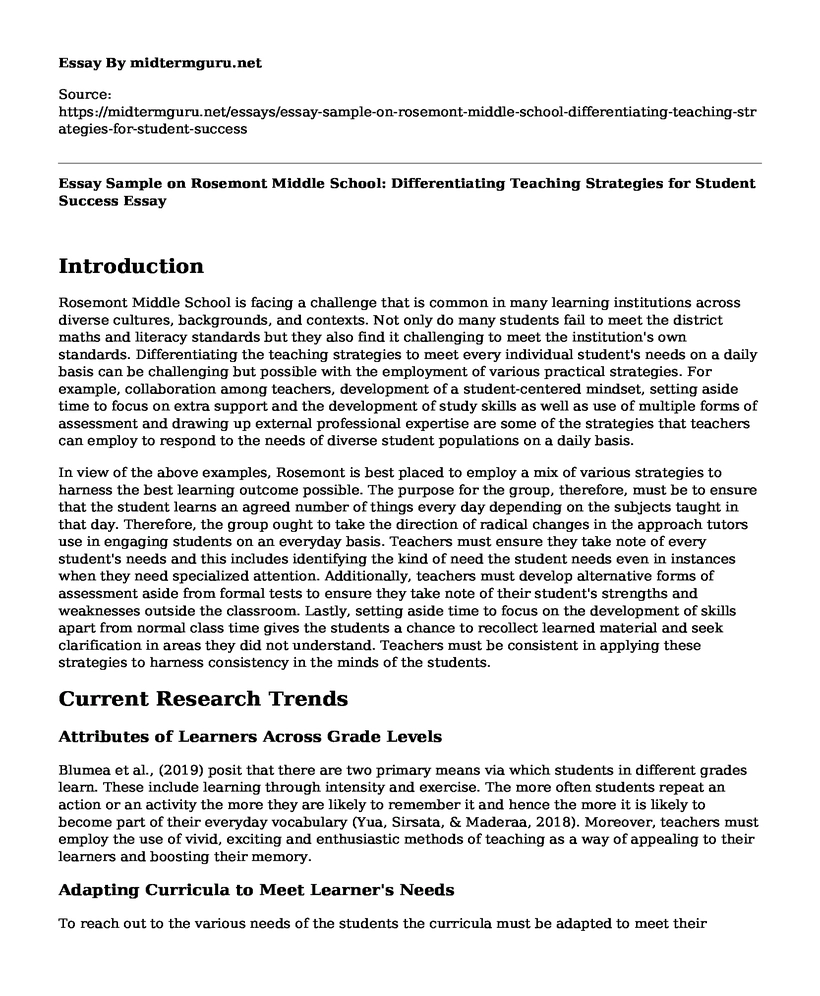Introduction
Rosemont Middle School is facing a challenge that is common in many learning institutions across diverse cultures, backgrounds, and contexts. Not only do many students fail to meet the district maths and literacy standards but they also find it challenging to meet the institution's own standards. Differentiating the teaching strategies to meet every individual student's needs on a daily basis can be challenging but possible with the employment of various practical strategies. For example, collaboration among teachers, development of a student-centered mindset, setting aside time to focus on extra support and the development of study skills as well as use of multiple forms of assessment and drawing up external professional expertise are some of the strategies that teachers can employ to respond to the needs of diverse student populations on a daily basis.
In view of the above examples, Rosemont is best placed to employ a mix of various strategies to harness the best learning outcome possible. The purpose for the group, therefore, must be to ensure that the student learns an agreed number of things every day depending on the subjects taught in that day. Therefore, the group ought to take the direction of radical changes in the approach tutors use in engaging students on an everyday basis. Teachers must ensure they take note of every student's needs and this includes identifying the kind of need the student needs even in instances when they need specialized attention. Additionally, teachers must develop alternative forms of assessment aside from formal tests to ensure they take note of their student's strengths and weaknesses outside the classroom. Lastly, setting aside time to focus on the development of skills apart from normal class time gives the students a chance to recollect learned material and seek clarification in areas they did not understand. Teachers must be consistent in applying these strategies to harness consistency in the minds of the students.
Current Research Trends
Attributes of Learners Across Grade Levels
Blumea et al., (2019) posit that there are two primary means via which students in different grades learn. These include learning through intensity and exercise. The more often students repeat an action or an activity the more they are likely to remember it and hence the more it is likely to become part of their everyday vocabulary (Yua, Sirsata, & Maderaa, 2018). Moreover, teachers must employ the use of vivid, exciting and enthusiastic methods of teaching as a way of appealing to their learners and boosting their memory.
Adapting Curricula to Meet Learner's Needs
To reach out to the various needs of the students the curricula must be adapted to meet their individual needs every day of their learning. First, the school can purpose to organize the students into groups according to their abilities, talents, and skills (Beatri, Alexandre, Enric, & Lopezc, 2019). Such an arrangement will give them the confidence to ask all the necessary questions to boost their understanding. Moreover, the school can utilize group work as opposed to classwork which will ensure that the teacher reaches out to little groups of students as opposed to a large group of the students. Lastly, the school can integrate learning with other physical activities and this will help in making learning fun and entertaining.
Learning Activities With the Best Outcomes
Some of the learning activities that harness the best learning outcomes include the integration of classwork with physical activities and the transformation of classwork into material that the students can easily dramatize and act out for easy remembrance and grasp of content.
Learning Technologies With the Best Outcomes
Modern technologies are essential in helping students grasp content and remember what they are taught in class. For example, the use of smartphones can enable students to interact with new material online through the internet. Additionally, the television contains kids games that teach students skills like grammar and arithmetic. Such technological tools, when used in the regulation, can be of great help to the students.
References
Beatri, A., Alexandre, H.-L., Enric, P.-L., & Lopezc, S. (2019). Applying learning analytics to students' interaction in business simulation games. The usefulness of learning analytics to know what students really learn. Computers in Human Behavior, 92(1), 600-612. doi.org/10.1016/j.chb.2018.03.001
Blumea, F., Gollnerb, R., Moellera, K., Dreslerbe, T., Ehlisbe, A.-C., & Gawrilowabf, C. (2019). Do students learn better when seated close to the teacher? A virtual classroom study considering individual levels of inattention and hyperactivity-impulsivity. Learning and Instruction, 61(1), 138-147.doi. 10.1016/j.learninstruc.2018.10.004.
Yua, H., Sirsata, S., & Maderaa, J. (2018). Enhancing hospitality students' motivation to learn food safety knowledge using tablet personal computer (TPC)-based simulation game class activity. Journal of Hospitality, Leisure, Sport & Tourism Education, 23(1), 82-94. doi.org/10.1108/00070701211219504
Cite this page
Essay Sample on Rosemont Middle School: Differentiating Teaching Strategies for Student Success. (2023, Jan 29). Retrieved from https://midtermguru.com/essays/essay-sample-on-rosemont-middle-school-differentiating-teaching-strategies-for-student-success
If you are the original author of this essay and no longer wish to have it published on the midtermguru.com website, please click below to request its removal:
- Essay Sample: My Strengths and Weaknesses of Learning English
- Annotated Bibliography on the Relationship Between Single Mothers and Poverty
- Autobiographical Essay Example
- Essay Sample on Teacher Pay in North Carolina
- Essay Sample on Significant Life Event
- NAEYC Standards in Early Childhood Education and Development - Paper Example
- Creating a Safe & Supportive Environment for Children's Growth & Development - Essay Sample







